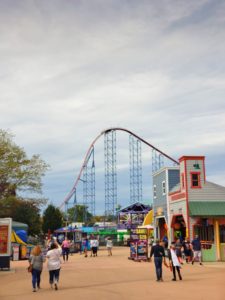 Six Flags America (SFA) has the unfortunate reputation of being one of the lower-end Six Flags parks, if not the lowest — either due to staffing, unreliable and uninspiring rides, or generally being left behind as its corporate parents figure out financial issues. But is this reputation well-deserved, or is this park an under-appreciated gem? I had the recent opportunity to visit SFA to find out for myself.
Six Flags America (SFA) has the unfortunate reputation of being one of the lower-end Six Flags parks, if not the lowest — either due to staffing, unreliable and uninspiring rides, or generally being left behind as its corporate parents figure out financial issues. But is this reputation well-deserved, or is this park an under-appreciated gem? I had the recent opportunity to visit SFA to find out for myself.
Being a part of the theme park enthusiast community, I tend to hear commentary on various parks quite frequently. SFA typically receives a bad rap from this community. Often, folks decry the lack of new rides in the park, or they report reliability issues with rides like Batwing and Joker’s Jinx. Others point out that operations are usually lacking and slow. All valid points, but this might be a slightly biased point of view considering the echo chamber that is the enthusiast scene, like any “tight-knit” group. And like most hobbyist groups, we hold what we like to a high standard. However, I like to believe in the positive side of things, keeping my expectations in check but with an open mind. Either way you look at it, you’re riding roller coasters at a theme park which is always fun.
Arriving at the park on a cool and cloudy Saturday morning in October, I walked up to the colonial-styled entrance. This being the era of Covid-19, guests were lined up outside and were processed through temperature checks and touchless security scans. The whole process took maybe 10 minutes, and I was impressed with how well and quickly the staff handled things. A quick note on Covid-19 policies: almost all guests were wearing masks, the staff was working hard to enforce social distancing and there were plenty of hand-washing stations with sanitizer available at every spot in the park. With membership and reservation in hand, I was in the park. And on the subject of first impressions with a theme park, the entrance plaza of SFA was adequate — not terrible, but certainly not amazing either. It is functional as it is, yet they could stand to renovate the front plaza. I’m sure renovating the buildings in the park would go a long way.
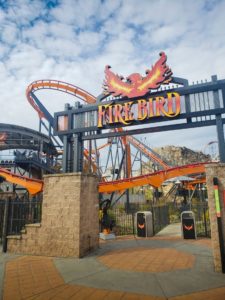 The layout of the park does not lend itself well to finding your way, which was compounded by the lack of maps. A quick app download later and problem solved (points for Six Flags’ robust mobile app and free in-park WiFi). Overall, the park has a state-fair feel. I quite like it, to be honest — it is very quaint. This is especially true in the fall with leaves blowing across the pathways. The best way I can describe the layout of this park is that it’s just like a Roller Coaster Tycoon (RCT) park — rides and coasters plopped around where they fit, and the paths feel like an afterthought. This is especially evident towards the back of the park where Superman and Batwing are built. Both coasters are sitting in a barren field with hardly any theming or landscaping. At least they keep it mowed; I always turned that job off for my handymen in RCT.
The layout of the park does not lend itself well to finding your way, which was compounded by the lack of maps. A quick app download later and problem solved (points for Six Flags’ robust mobile app and free in-park WiFi). Overall, the park has a state-fair feel. I quite like it, to be honest — it is very quaint. This is especially true in the fall with leaves blowing across the pathways. The best way I can describe the layout of this park is that it’s just like a Roller Coaster Tycoon (RCT) park — rides and coasters plopped around where they fit, and the paths feel like an afterthought. This is especially evident towards the back of the park where Superman and Batwing are built. Both coasters are sitting in a barren field with hardly any theming or landscaping. At least they keep it mowed; I always turned that job off for my handymen in RCT.
After orienting myself and heading off in a random direction, I ended up at my first ride for the day, Firebird. Firebird is a Bolliger & Mabillard (B&M) floorless coaster with an interesting history. First opening up as a stand-up coaster, Iron Wolf, at Six Flags Great America in 1990, it was the first coaster created by the then-new B&M. It was relocated to SFA in 2012 and renamed Apocalypse. In 2019, the ride received a refurbishment in the form of fresh paint, sit-down floorless trains and was renamed Firebird. In my opinion, the effort paid off — the ride looks amazing with its fiery orange color, and the new trains are a welcome improvement.
The ride experience is still a little shaky in parts, but overall its old-school B&M design still shines through with fast and whippy transitions, forceful elements and that classic roar of the trains. I think the ride is more intense because the original track profile and heart-lining is designed for the stand-up trains. It is by no means an amazing ride, but it’s well-executed and fun to ride.
Walking under The Wild One, I made my way into the Gotham City section of the park and over to Joker’s Jinx. This Premier Rides linear induction motor (LIM) catapult coaster opened for the 1999 season. Being a clone of several other “spaghetti bowl” coasters, it is still pretty unique with its eye-catching green and purple paint scheme and open layout. Being outside, you can really appreciate the tangled mess of supports and track as you walk around it all. Riding said mess is an amazing experience. When the ride launches, it mercilessly shoves your head, body and organs back as you are shunted down the launch tunnel and into the “bowl.”
Each element and inversion is forceful and smooth, the train gracefully climbing up the structure as it navigates a cobra roll and a sidewinder. The second half, however, is the most insane part. Picking up speed as you twist back down through the superstructure, the train pitching and banking wildly as it goes along with a surprise corkscrew taken at full speed for the finale. I love this ride, and I love launched coasters. The tight clearances and abundant “head-choppers” had my hands and arms firmly in the car. The maniacal speed and insane forces kept a smile painfully spread across my face, just as the Joker would’ve wanted.
My next ride was Batwing, the 2001 yellow Vekoma Flying Dutchman nestled in a field way back in the rear of the park. Stepping off of Joker, I walked down past Superman and made the meandering trip towards Batwing. I was happy to see that it was running that morning, I have often heard reports of it suffering from extended periods of downtime. I have ridden Nighthawk at Carowinds, another “Flying Dutchman” coaster. I was never a big fan of Nighthawk, so my bar was already low. Besides that, Nighthawk (originally Stealth at California’s Great America) was the prototype for this model, so I was interested in seeing the differences between the two rides.
The ride experience was comparable to Nighthawk, which was expected, but what surprised me that it was somehow smoother! The vest restraints felt nice, and I prefer them to the B&M Flying coaster restraints. 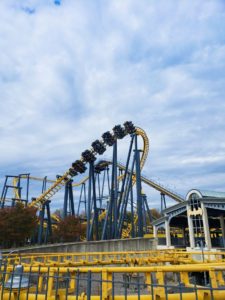 My favorite part of the Flying Dutchman coasters is the signature vertical loop in the middle of the layout. It is just the right size, incredibly forceful and pretty to look at! Batwing finishes its layout with two in-line twists and a helix, which is a nice change from the two corkscrews at the end of Nighthawk. I think I prefer the corkscrews more, but the in-line twists are fun and smooth! Overall, I was quite pleased with this ride and happy to have gotten a ride on it!
My favorite part of the Flying Dutchman coasters is the signature vertical loop in the middle of the layout. It is just the right size, incredibly forceful and pretty to look at! Batwing finishes its layout with two in-line twists and a helix, which is a nice change from the two corkscrews at the end of Nighthawk. I think I prefer the corkscrews more, but the in-line twists are fun and smooth! Overall, I was quite pleased with this ride and happy to have gotten a ride on it!
Walking back from the isolated Batwing, my next stop was Superman: Ride of Steel. Its looming 200-foot-tall lift hill visible from most of the park, this was the signature attraction at SFA when it opened in 2000. An Intamin hypercoaster, this ride is situated across the same field that Batwing resides in. The red track of Superman twisting off into the distance, never to be seen, creates a sense of intimidation and excitement. The ride’s station and presentation, however, leave much to be desired. Rust, cracking and peeling paint, faded graphics and lettering as well as overgrown weeds all add up to a subpar execution. Slow operations make sure that only a few trains dispatch an hour.
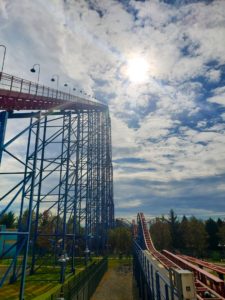 This was also the only coaster where the ride operators seemed unhappy and unfriendly. The ride experience is okay, nothing great. A solid but uninspiring first drop into a forceful right turn leads into a nice floater air-hill. The following helix was alright but weak. It was followed by a puzzling piece of straight track that stretches for hundreds of feet. A quick and snappy bunny hill follows before entering yet another boring helix. A few bunny hills later and back into the station. The trains rattle and shake across the track, as several loose bits of fairing vibrate and move around. The tight fit of the seats is uncomfortable at best, and the lap bars pinch into your legs. If the layout was fun, that would be one thing, but overall it feels like a poorly planned coaster from RCT. The small amounts of airtime are nice and it is an adequate coaster, but that’s it. Just adequate.
This was also the only coaster where the ride operators seemed unhappy and unfriendly. The ride experience is okay, nothing great. A solid but uninspiring first drop into a forceful right turn leads into a nice floater air-hill. The following helix was alright but weak. It was followed by a puzzling piece of straight track that stretches for hundreds of feet. A quick and snappy bunny hill follows before entering yet another boring helix. A few bunny hills later and back into the station. The trains rattle and shake across the track, as several loose bits of fairing vibrate and move around. The tight fit of the seats is uncomfortable at best, and the lap bars pinch into your legs. If the layout was fun, that would be one thing, but overall it feels like a poorly planned coaster from RCT. The small amounts of airtime are nice and it is an adequate coaster, but that’s it. Just adequate.
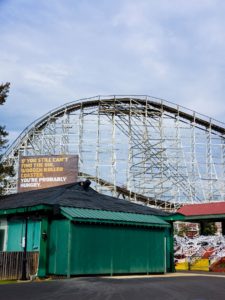 Next, I headed back over to Wild One. It is surprisingly easy to get to once you figure out how — the neat path cuts under Wild One’s structure and through the Mardi Gras section. And the coaster itself is pretty neat, being over 100 years old after having been relocated to SFA in 1986. While the ride is shaky and rough, the park does a good job keeping it in good running shape. If they smoothed the whole thing out I feel like it would lose most of its old-school charm and character. And speaking of character, this is a true classic! Registered as an American Coaster Enthusiasts (ACE) Landmark, Wild One is one of the best rides in the park. It offers an exhilarating ride packed with air time and strong lateral forces. It’s a fun out-and-back layout with the coaster racing through the park offering riders great views of Firebird, Superman and Roar. The double-down and double-up are amazing, but my favorite part is the end. The unbanked helix finale is bonkers; you can feel the track bending and stressing under you as the train hammers through the turn. This is a great ride, and I hope they keep it around for another 100 years.
Next, I headed back over to Wild One. It is surprisingly easy to get to once you figure out how — the neat path cuts under Wild One’s structure and through the Mardi Gras section. And the coaster itself is pretty neat, being over 100 years old after having been relocated to SFA in 1986. While the ride is shaky and rough, the park does a good job keeping it in good running shape. If they smoothed the whole thing out I feel like it would lose most of its old-school charm and character. And speaking of character, this is a true classic! Registered as an American Coaster Enthusiasts (ACE) Landmark, Wild One is one of the best rides in the park. It offers an exhilarating ride packed with air time and strong lateral forces. It’s a fun out-and-back layout with the coaster racing through the park offering riders great views of Firebird, Superman and Roar. The double-down and double-up are amazing, but my favorite part is the end. The unbanked helix finale is bonkers; you can feel the track bending and stressing under you as the train hammers through the turn. This is a great ride, and I hope they keep it around for another 100 years.
Before leaving the area, I had to take a quick spin on the park’s flyers. I love these things and ride them every chance I get. But before too long, I was making my way to Roar, the park’s Great Coasters International (GCI) wooden twister coaster. Debuting in 1998, this was only the second GCI to be built following Hersheypark’s Wildcat. I had no expectations for this ride going in, but considering how fun of a ride Wild One gave, I was excited for Roar. I was not disappointed either, this ride is fun immediately after leaving the station with a short pre-lift section.
The sweeping drop is a lot of fun, even more so at night, and the layout is unrelenting. Twisting and diving under and over itself, this undulating mass of wood and steel provides intense thrills. The trains’ shuffling from side to side, never quite feeling like they were on track, definitely gave a heightened sense of being out of control. The speed kept building through the ride, the best moment being at full speed as you whizzed and twisted through a “tunnel.” I had a lot of good laughs on this ride as it is a fantastic coaster. Yet another underappreciated ride, I hope they keep this one as is. People talk about converting this one into a hybrid coaster, but I think it’s fine as it is. (pic: Roar entrance)
Departing from Roar’s area, I could see my last stop poking above the buildings. The yellow and orange track twisting in and out of view, staying mostly out of sight as I walked up to it. Mind Eraser, the park’s Vekoma Suspended Looping Coaster, is isolated in its own little corner of the park. Neatly nestled on a hill surrounded by trees, it’s quite a lovely spot for a roller coaster. Mind Eraser opened in 1995 and has been thrilling guests since. This coaster, along with other models of its ilk, has developed a bad reputation for having a rough ride, painful elements and just generally a terrible experience. However, I have never had the chance to ride an SLC before so I was looking forward to this experience. Sure it might be bad, but it was “new (to me)” bad. I was surprised at how small the trains were, and how close my head was to the track, but I thought the seat was comfortable enough. Riding it wasn’t exactly what I would call comfortable, but it was not a bad time either. Dropping off of the lift and into the layout, the ride delivered an intense and enjoyable experience. The layout is jam-packed with elements and relentless pacing. Sure, some of the twists and turns felt like I was in a concrete mixer, but I have ridden rides that are much, much worse. There might be rougher SLCs out there, but I thought this one was relatively smooth. I’ll have to ride more to compare, but I enjoyed Mind Eraser for what it is.
After having my back adjusted on Mind Eraser, it was time to get lunch, rest and come back for night rides. Being this close to Halloween, of course, Six Flags has an event. Dubbed “Hallowfest,” the park is adorned with spider webs, scare actors, copious amounts of fog and other spooky theming — standard fare for a park this time of year. Coming back into the park, it was very clear that the crowds had come and everyone was here to get a little spooky. Unlike the day there were lines everywhere in the park with wait times reaching past one or two hours, or even worse with Batwing running only one train.
But I did manage to get several rides on Joker’s Jinx, despite it going down for a little while. Its crazy layout is even more insane in the dark. Having been warmed up from the day, it was hauling. Roar also benefited from the day-long warm-up, ripping through its layout like a demon as it sped through the darkness. Roar was by far my favorite night ride, somehow it became more demented after the sun set and the lights went out. Firebird had its fire effects going, and with the lights turned off it was a blast at night. The lines for Superman and Batwing were just too crazy to even think about, to the point where staff members were handing out time reservation cards. The idea being you can come back at a certain time to get in line. Not a bad idea to keep crowds under control, but ultimately useless as the park handed out cards with all the same time on it. Coming back at the time I was told to, the line was even longer than before! After getting one last ride on Joker’s Jinx, it was time to call it a day.
I did not get a chance to experience Ragin Cajun, the Zamperla spinning wild mouse coaster close to Wild One. I’ve been on similar rides in the past, and while I do enjoy wild mouse coasters, the spinning ones don’t do much for me. It seems to be a great ride, however, and a park favorite since it always seemed to have a line. And that is something I noticed about the park in general, the public going there absolutely loves the place. Listening into passerby’s conversations, everyone is excited about something. Be it gossiping about Superman, or talking up Batwing, to raving about Joker’s Jinx, lots of people really seem to enjoy being in this park. There are tons of happy kids and laughing adults — the only people saying bad things about this place are the enthusiasts. This is understandable, but it helps to look at things from a different perspective.
The staff too seems to enjoy their jobs; I had several fun conversations with employees throughout the day, and each one seemed to really care about the place. Maybe I went on a good day, but I don’t feel like this park deserves the reputation it has among parkgoers. Everyone in the area loves this park, and while it’s not my favorite, it does have a certain charm about it. Yes, the rides are lacking and everything feels a bit run down, but that’s ok. What’s important is that it is all still here, and we are all lucky to have another park to visit and coasters to ride. Because at the end of the day, the name of the game is having fun. And I had a lot of fun at Six Flags America.
About the Author:
 Matthew Loof works in Charlotte, NC in sales, engineering, marketing and design with an eye toward the future hoping to break into the amusement industry. He’s been a roller coaster nut since a child and dreams of visiting all the parks in the world someday. He enjoys riding classic rides as much as newer ones — the more intense and faster the better!
Matthew Loof works in Charlotte, NC in sales, engineering, marketing and design with an eye toward the future hoping to break into the amusement industry. He’s been a roller coaster nut since a child and dreams of visiting all the parks in the world someday. He enjoys riding classic rides as much as newer ones — the more intense and faster the better!

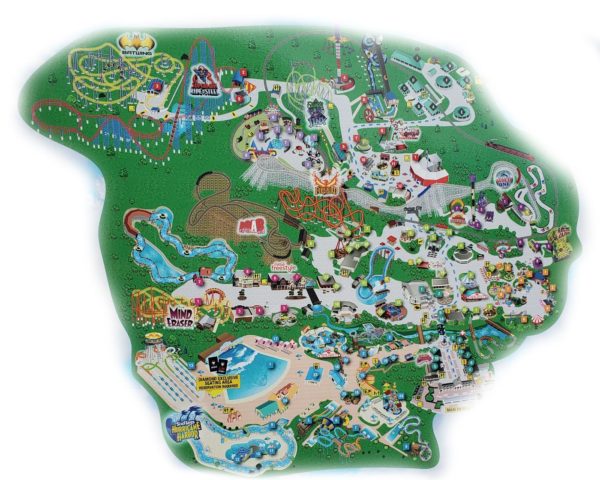
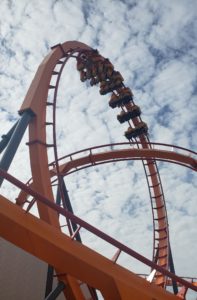
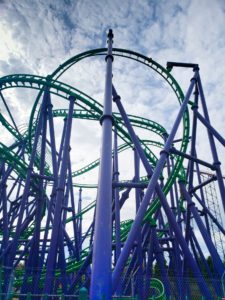
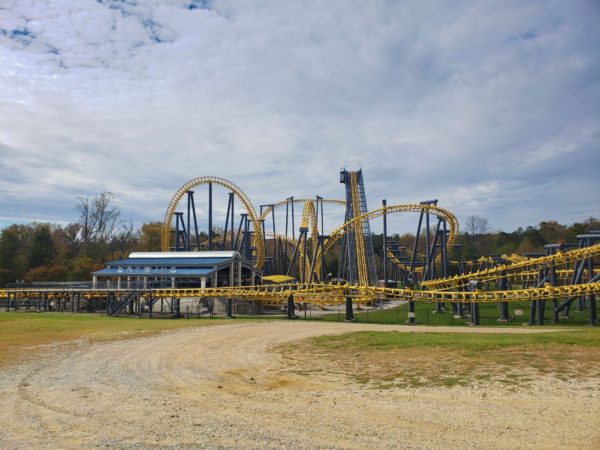
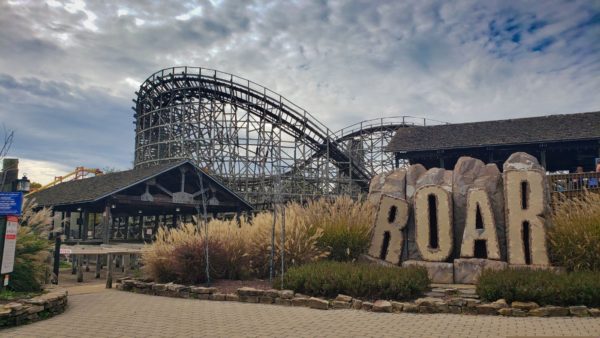
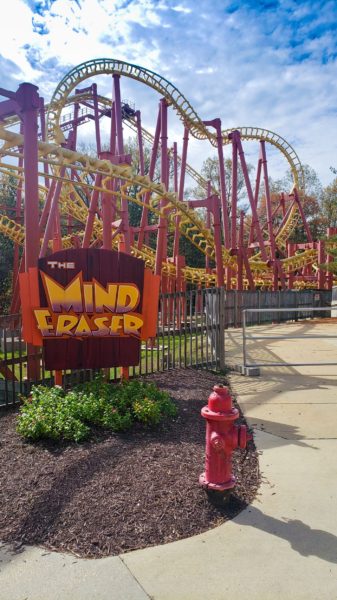
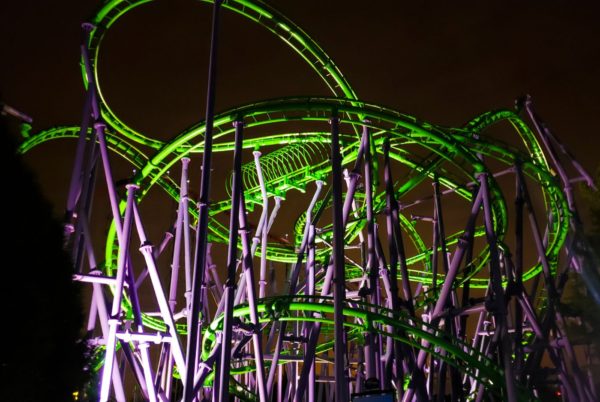
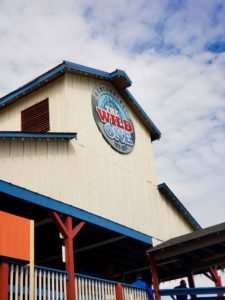
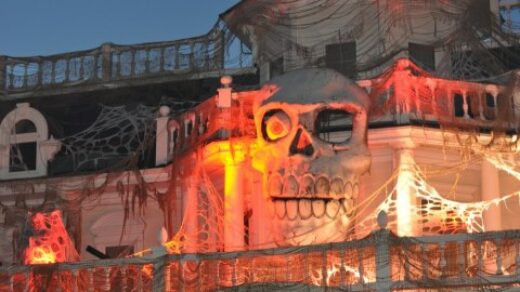
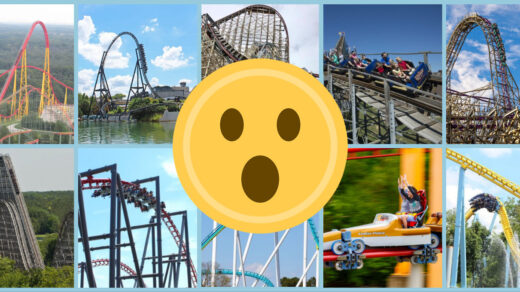
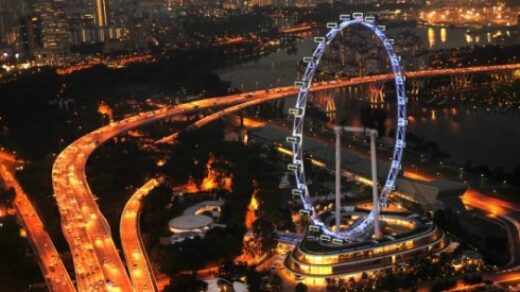





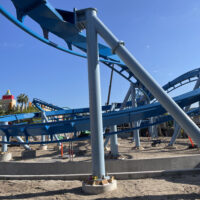





I feel like attendance at Six Flags America actually increased this year (or at least stayed the same since they opened late) since Kings Dominion didn’t open until December.
!!!
My son and I received a terrible and shame experience just yesterday at Six Flags’ bumper car site!
Several months ago I took my son to Six Flags near DC. The operater of Bumper Car didn’t let my son ride it, because my son’s height was just beneath the line. Ok, there was no problem. I persuaded my son to leave even he cried very hard.
Now my son is 1.5 inchs taller than 3 months ago. On our way walking to the Bumper Car site, he was very pleased to talk to me he grew taller, so that this time he would be qualified to ride the bumper car to which he was looking forward for 3 months.
But the operator still didn’t let him in! Even after I used my handset to press tightly on my son’s head before the staff gauge at the entrance and showed her my son is definitely at least one inch higher than the line, she insisted he could not enter. Why? ! Is the staff gauge standing there for measuring player’s height? Does the line on the staff mean if you are taller than it you can ride?
My son was crying again and repeated ” I am taller! I am taller!” . This time I had no reason to persuade him to leave. This is my right! I bought the pass and he is tall enough to ride it. So I insisted she should let my son in, or asked her manager to come here!
She fiddled with her hand phone for maybe 10 minutes and let us in eventually. But I was very upset and mad. I could also feel my son was hurt. When I asked him to ride it again, he refused. His smiling disappeared in our rest time at the Park. I made a complaint against the operator at the Park’s Guest Relations Centre. But it already destroyed my son’s happy day!
My son meets all the requirements of ride that Bumper Car, but was still blocked there for almost 15 minutes! Only because we are Asian!? She already let a boy three people before us in, and I don’t think that boy is taller than my son. I should call the police instead of her manager. It is discrimination!